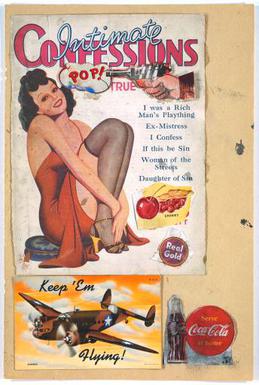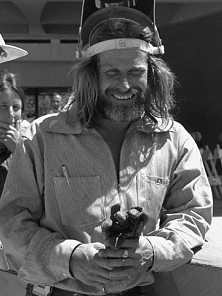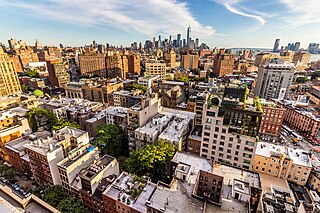Related Research Articles

Pop art is an art movement that emerged in the United Kingdom and the United States during the mid- to late-1950s. The movement presented a challenge to traditions of fine art by including imagery from popular and mass culture, such as advertising, comic books and mundane mass-produced objects. One of its aims is to use images of popular culture in art, emphasizing the banal or kitschy elements of any culture, most often through the use of irony. It is also associated with the artists' use of mechanical means of reproduction or rendering techniques. In pop art, material is sometimes visually removed from its known context, isolated, or combined with unrelated material.
Abstract expressionism in the United States emerged as a distinct art movement in the immediate aftermath of World War II and gained mainstream acceptance in the 1950s, a shift from the American social realism of the 1930s influenced by the Great Depression and Mexican muralists. The term was first applied to American art in 1946 by the art critic Robert Coates. Key figures in the New York School, which was the epicenter of this movement, included such artists as Arshile Gorky, Jackson Pollock, Franz Kline, Mark Rothko, Norman Lewis, Willem de Kooning, Adolph Gottlieb, Clyfford Still, Robert Motherwell and Theodoros Stamos among others.

Leon Golub was an American painter. He was born in Chicago, Illinois, where he also studied, receiving his BA at the University of Chicago in 1942, and his BFA and MFA at the Art Institute of Chicago in 1949 and 1950, respectively.

Leo Castelli was an Italian-American art dealer who originated the contemporary art gallery system. His gallery showcased contemporary art for five decades. Among the movements which Castelli showed were Surrealism, Abstract Expressionism, Neo-Dada, Pop Art, Op Art, Color field painting, Hard-edge painting, Lyrical Abstraction, Minimal Art, Conceptual Art, and Neo-expressionism.

Marco Polo di Suvero, better known as Mark di Suvero, is an abstract expressionist sculptor and 2010 National Medal of Arts recipient.

The 9th Street Art Exhibition of Paintings and Sculpture is the official title artist Franz Kline hand-lettered onto the poster he designed for the Ninth Street Show. Now considered historic, the artist-led exhibition marked the formal debut of Abstract Expressionism, and the first American art movement with international influence. The School of Paris, long the headquarters of the global art market, typically launched new movements, so there was both financial and cultural fall-out when all the excitement was suddenly emanating from New York. The postwar New York avant-garde, artists like Willem de Kooning and Jackson Pollock, would soon become "art stars," commanding large sums and international attention. The Ninth Street Show marked their "stepping-out," and that of nearly 75 other artists, including Harry Jackson, Helen Frankenthaler, Michael Goldberg, Joan Mitchell, Grace Hartigan, Robert De Niro Sr., John Ferren, Philip Guston, Elaine de Kooning, Lee Krasner, Franz Kline, Ad Reinhardt, David Smith, Milton Resnick, Joop Sanders, Robert Motherwell, Barnett Newman, and many others who were then mostly unknown to an art establishment that ignored experimental art without a ready market.
The Chicago Imagists are a group of representational artists associated with the School of the Art Institute of Chicago who exhibited at the Hyde Park Art Center in the late 1960s.
The Green Gallery was an art gallery that operated between 1960 and 1965 at 15 West 57th Street in Manhattan, New York City. The gallery's director was Richard Bellamy, and its financial backer was the art collector Robert Scull. Green Gallery is noted for giving early visibility to a number of artists who soon rose to prominence, such as Yayoi Kusama, Mark di Suvero, Donald Judd, and George Segal.
Gemini G.E.L., formally Gemini Ltd., is an artists‘ workshop, exhibition space, and publisher of limited edition prints and sculptures, located at 8365 Melrose Avenue in Los Angeles, California.
Max Kozloff is an American art historian, art critic of modern art and photographer. He has been art editor at The Nation, and Executive Editor of Artforum. His essay "American Painting During the Cold War" is of particular importance to the criticism on American Abstract Expressionism.
The Foundation for Contemporary Arts (FCA), is a nonprofit based foundation in New York City that offers financial support and recognition to contemporary performing and visual artists through awards for artistic innovation and potential. It was established in 1963 as the Foundation for Contemporary Performance Arts by artists Jasper Johns, John Cage, and others.

Irving Petlin was an American artist and painter renowned for his mastery of the pastel medium and collaborations with other artists and for his work in the "series form" in which he employed the raw materials of pastel, oil paint and unprimed linen, and found inspiration in the work of writers and poets including Primo Levi, Bruno Schulz, Paul Celan, Michael Palmer and Edmond Jabès.

Joyce Kozloff is an American artist known for her paintings, murals, and public art installations. She was one of the original members of the Pattern and Decoration movement and an early artist in the 1970s feminist art movement, including as a founding member of the Heresies collective.

Museo Rufino Tamayo is a public contemporary art museum located in Mexico City's Chapultepec Park, that produces contemporary art exhibitions, using its collection of modern and contemporary art, as well as artworks from the collection of its founder, the artist Rufino Tamayo.
The Irascibles or Irascible 18 were the labels given to a group of American abstract artists who put name to an open letter, written in 1950, to the president of the Metropolitan Museum of Art, rejecting the museum's exhibition American Painting Today - 1950 and boycotting the accompanying competition. The subsequent media coverage of the protest and a now iconic group photograph that appeared in Life magazine gave them notoriety, popularized the term Abstract Expressionist and established them as the so-called first generation of the putative movement.
Thomas Kellein is a German art historian; gallery director; author; and curator. He was the Director at Kunsthalle Basel between 1988 and 1995, and the Director of the Kunsthalle Bielefeld between 1996 and 2010. He was the Director of the Chinati Foundation between 2011 and 2012.
Kent Fine Art is an art gallery in New York City founded in 1985 by Douglas Walla.
Robert Scull was an American art collector, best known for his "world-famous collection of Pop and Minimal art". Born in New York to Russian immigrant parents, Scull dropped out of high school and had various jobs until his wife inherited a share of a taxi business. When this thrived, the couple started buying abstract art and later pop art.
References
- ↑ Drohojowska-Philp, Hunter (Mar 15, 2012). "Peace Tower Resurrected". KCRW. Archived from the original on Oct 27, 2017.
- ↑ Kastner, Jeffrey (March 2006). "1000 Words: Peace Tower; Irving Petlin, Mark Di Suvero, and Rirkrit Tiravanija Revisit the Artists' Tower of Protest, 1966". Artforum International. 44 (7).
- Selz, Peter (2010). "Irving Petlin: the Committed Brushstroke". Art in America. 98 (3): 106–115.
- Selz, Peter & Susan Landauer (2005). Art of Engagement: Visual Politics in California and Beyond. University of California Press, Berkeley. p. 47.
- "Potpourri of Protest". Newsweek: 101. March 14, 1966.
- "The Arts: Protest on All Sides". Newsweek: 83. July 10, 1967.
- Schwartz, Therese (November–December 1971). "The Politicalization of the Avant-Garde". Art in America. 59 (Six): 96–105 and front cover.
- Kozloff, Max (May 1973). "American Painting during the Cold War". Artforum. 11: 43–54.
- Petlin, Irving; Mark di Suvero; Rirkrit Tiravanija (March 2006). "1000 Words: Peace Tower". Artforum. XLIV (7): 252–257 and front cover.